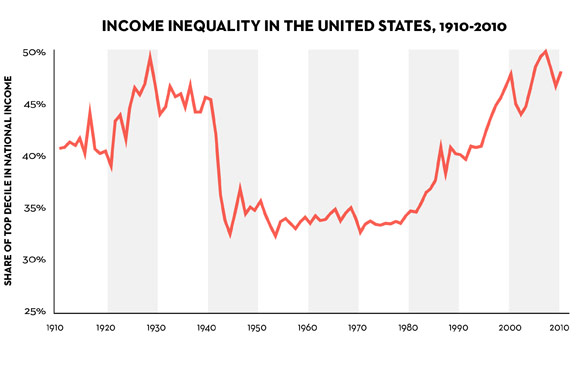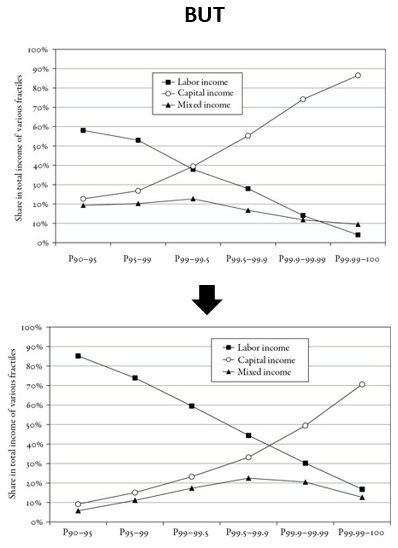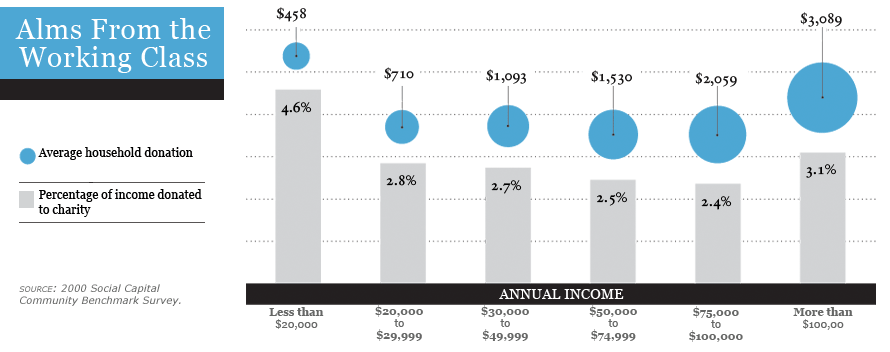By now, Thomas Piketty’s U-shaped graphs of wealth and income concentration are well known. What has received less attention are the differences between the last, early-20th-century inequality peak and today. One important difference is that the composition of wealth and income has changed: more of the income of the wealthy today comes from (ostensibly, at least) work.

 Figure 1. Income going to the top 10% in the US over time followed by distribution of income between labour and capital income in the US, 1929 and 2007. (Sources: New Yorker and Capital in the Twenty-First Century, Figs. 8.9 and 8.10)
Figure 1. Income going to the top 10% in the US over time followed by distribution of income between labour and capital income in the US, 1929 and 2007. (Sources: New Yorker and Capital in the Twenty-First Century, Figs. 8.9 and 8.10)It seems not a month goes by without a new study highlighting that CEOs today are earning some enormous multiple of average worker pay. The latest figures put the pay of Canada’s top 100 CEOs at 171 times the average wage. Today’s top billionaires may be richer than Roman emperors but they are more likely to put in a 40-hour-or-more week. While Piketty is not the first to notice that the last few decades have witnessed a profound transformation in the upper class and the rise of “supermanagers”, he provides some of the best data on the exact shape of this enormous change.
The scope of the changes goes far beyond the relative weight of income sources. The rise of a numerically very small class of supermanagers at the top has had impacts on the perceptions and the culture of wealth and work throughout society – and it is this that remains less clear. We know who the supermanagers are, but we know a lot less about how we’ve all changed because of their rise. Certainly, their existence and social position reinforces the tendency towards an acceptance of meritocracy – no matter how much we diverge from it and despite mounting inequalities of resources that are incommensurable with inequalities of skill, education or creativity. The scope of changes, however, goes beyond merit and just desserts: a complex web of material and cultural changes mediated by changing institutions.
In the context of individual, cultural change, it is useful to bring up the work of psychologists like Paul Piff who have studied the effects of wealth on values, attitudes and behaviour. In short, study after study has found intense class-based differences across how people think and act – differences that, in general, do not reflect positively on the rich. One well-known finding is that the rich actually are relatively less charitable then those with low incomes. It is well-known that, generally, the poorer you are, the larger piece of your income you give to charity. Only the very wealthiest give a higher percentage of their income and this is largely aimed at things like “high” arts of which they are primary patrons or the funding of legacies and abetting reputations (named business schools and the like).

Such behaviour accords well with self-reinforcing meritocratic beliefs. Somewhat more cynically, it’s possible to note that the poorest may have been hoodwinked into confusing charity for justice – more charitably, perhaps we simply understand that we will not be getting justice anytime soon and so resort to the lousy second-best of charity, in particular when the welfare state is being slowly dismantled.
The studies carried out by psychologists go much further in cataloguing the social psychology of modern meritocracy. A notable example is a study that found how easy it is to attribute money-making luck to skill. Two players play a game of Monopoly that is rigged so that one player has to win (she gets more money at the start and on each passing of “Go!”). The roles are decided by a coin toss at the start. Perhaps less surprisingly, over the course of the game, the winning player usually became more self-assured engaged in overt displays of power. More tellingly, after the game, winners were likely to attribute their success to skill and (mental) effort rather than chance despite having been explained the rigged rules and witnessing the coin toss. The game was “managed” through skill and the success is testament to it.
Indeed, the old aristocratic value of noblesse oblige is today apparently less of a value the wealthier you are. Today’s wealthy are liable to think they worked their way to the top. On the one hand, this is really true. Not only are workers working longer on average (link to own blog), so are top managers. Economic data is useful in putting a different lens to these social psychology studies. Without the context of broader class dynamics like the rise of supermanagers, the studies can easily give way to moralizing. While they are often construed as morality tales about the value of being nice or the virtues of moderation, their real value lies in shedding light on how the changes in economic relationships are remaking who we are.
Put differently: while the language of precarity is useful, in some sense, workers have always precarious; the wealthiest have, however, not always been managers. The now popular story about vast patterns in distribution needs additional grounding. We need a history of “the making of the working capitalist” that will at once implicitly tell an important part of the story of the remaking of the working class in the neoliberal age.